Home to rolling prairies and famed state parks, South Dakota remains a popular destination for nature lovers. You’ll be glad to know you can find 15 species of finch here!
These little songbirds continue to amaze me with their adaptability. Despite the fact there are few forests in South Dakota, finches continue to thrive year-round.
These birds are incredibly popular among bird watchers because they’re easy to spot in the wild, but they also like to visit bird feeders. Their varied songs, gorgeous plumage, and sociable nature make them a real treat to observe.
Thinking of trying a little bird-watching? I’ll take a look at South Dakota’s colorful and charming finch population with tips on appearance, birdsong, and more.
Purple Finch

- Species Name: Haemorhous purpureus
- Length: 12 cm to 16 cm
- Weight: 18 grams to 32 grams
- Wingspan: 22 cm to 26 cm
South Dakota winters may be intense, but the purple finch is keen to liven things up. Their stunning plumage stands out beautifully against the snow.
Appearance
The male purple finch, surprisingly enough, isn’t actually purple! Their bodies are covered in a brilliant reddish-pink with a little brown along their wings.
Their white rump and pale bill contrast the rest of their plumage beautifully. If you use binoculars, you can see their little notched tail.
The female purple finch looks more sparrow-like with her brown feathers and white streaks. She has a spotted stomach that almost blends her in with the trees.
Range
Purple finches usually show up during the winter months in South Dakota. However, you may still glimpse them during summer and fall.
Purple finches generally prefer dense forests, hence why they’re a little rarer in the state. They also show up in quieter urban areas if there’s enough shrubbery and undergrowth.
Diet
Purple finches enjoy a little bit of everything. They’ll forage for seeds, berries, insects, and various plant matter.
Some of their absolute favorite foods to eat are beech seeds, strawberries, and nectar.
Attracting them to your feeder is a matter of picking the right food and the right time. Stock up on millet, thistle, and sunflower seeds once winter rolls around – you’ll likely see a few!
Birdsong
The purple finch has a lovely, lilting warble with rising and falling notes. They’ll also let out the occasional whistle or chirp.
Fun Fact
Male birds have a charming mating dance where they vibrate their wings and hover in the air.
Pine Siskin
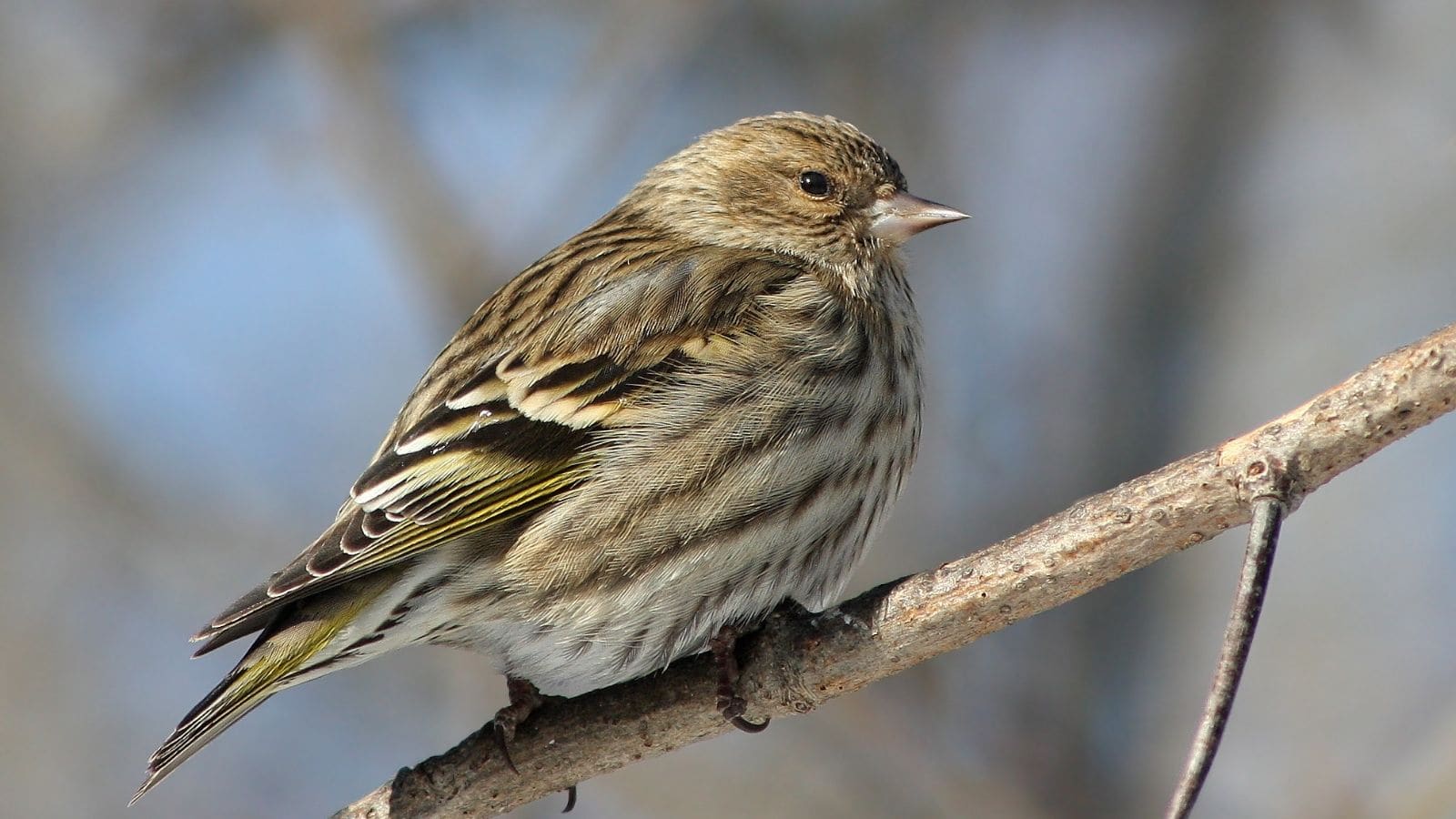
- Species Name: Spinus pinus
- Length: 11 cm to 14 cm
- Weight: 12 grams to 18 grams
- Wingspan: 18 cm to 22 cm
This darling finch looks like a completely different species at a glance. They have a more compact body and a smaller bill than many members of the finch family.
Appearance
Male pine siskins are tiny and adorable, covered in a light yellow with heavy flecks of brown. Their smaller beak almost gives them a sparrow-like appearance, but they’re most definitely all finch.
The female pine siskin has a similar appearance to the males but with less yellow on her wings.
Range
Pine siskins show up in most of South Dakota during non-breeding season, but may linger year-round in the southwestern part of the state. They’re most comfortable in spruce forests and shrubby areas.
You may be able to glimpse a few at popular state parks such as the Lewis and Clark Recreation Area.
Diet
Their name is their first clue to what they love to eat — pine seeds! They’re also not about to avoid a well-stocked feeder once winter hits.
Make sure you use thistle or unshelled sunflower seeds since their tiny beaks make it hard to eat anything larger.
Birdsong
Pine siskins are one of the happiest-sounding finches around. They emit long, buzzing trills that sound like tweee or tzweee.
Fun Fact
Foraging pine siskin flocks have the adorable habit of ‘leapfrogging’ over other members.
House Finch
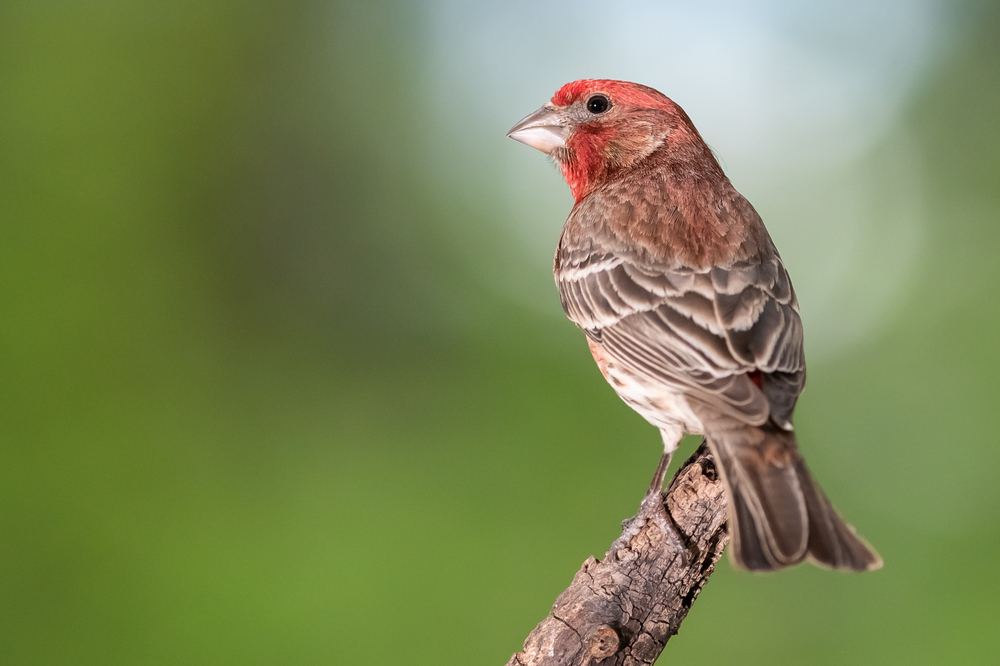
- Species Name: Haemorhous mexicanus
- Length: 13 cm to 14 cm
- Weight: 16 grams to 27 grams
- Wingspan: 20 cm to 25 cm
At a glance, you may think a house finch is a purple finch. These birds are still quite different in both their appearance and behavior.
Appearance
The house finch shares the purple finch’s love for red, but that’s where the visual similarity ends. Male house finches have a slimmer body and more brown plumage.
Female house finches are also pretty different from female purple finches. Their body is a little more evenly colored and leans toward a grayish-brown.
Range
House finches aren’t shy in the least. While they usually show up in the eastern portion of the state, they’re quite common in urban and suburban areas.
While you’re out on a walk, keep an eye out for their sociable flocks. These birds love to visit parks, gardens, and well-tended neighborhoods.
Diet
House finches are among the most adaptable birds thanks to their well-rounded diet. They’ll eat flower buds, seeds, fruits, berries, and various plant matter.
These birds adore feeders and will even confront other bird species for feeding rights. Stay stocked on safflower and sunflower seeds to bring them to your yard.
Birdsong
The house finch has a characteristically rich song of long, melodic warbles. You’ll notice their notes are often higher-pitched.
Fun Fact
House finches and purple finches vary a little in terms of environment. The former is more comfortable with urban settings, while the latter prefers forested areas.
Blue Grosbeak

- Species Name: Passerina caerulea
- Length: 14 cm to 19 cm
- Weight: 26 grams to 31 grams
- Wingspan: 26 cm to 29 cm
This is one finch you couldn’t misidentify if you tried. They’re one of the few with striking blue plumage that instantly pops against the earthy South Dakotan landscape.
Appearance
The male blue grosbeak has jewel-like plumage, covered in brilliant blue with chestnut brown wing bars. His conical bill is thick and pale, almost like a parrot’s.
The female blue grosbeak is equally lovely with her light gray-brown body and brown wing bars. She has hints of blue along her rump and her back.
Range
These shy finches usually show up in the southern portion of the state during the breeding season. They’re one of the harder finches to observe due to their tendency to hide in shrubby and overgrown areas.
Blue grosbeaks are most comfortable in thickets, hedgerows, forested clusters, and shrubby fields.
Diet
Blue grosbeaks are rather interesting among finches due to their preference for insects. They have a fondness for crunchy species such as grasshoppers, beetles, and cicadas.
However, they are still finches – they’ll eat a few seeds here and there to store up their fat content.
You can attract blue grosbeaks with black oil sunflower seeds, but only if your feeder is in a shrubby, overgrown area. This strategic placement makes them feel more comfortable.
Birdsong
You’re more likely to hear a blue grosbeak before seeing one. They let loose light, soft warbles, and occasional buzzing trills.
Fun Fact
While male and female blue grosbeaks will communicate vocally, only the males will sing.
Evening Grosbeak

- Species Name: Hesperiphona vespertina
- Length: 16 cm to 22 cm
- Weight: 38 grams to 68 grams
- Wingspan: 30 cm to 36 cm
Evening grosbeaks are another stunning finch with unique plumage. In fact, you may think you’ve run into a parrot instead of a finch!
Appearance
Male evening grosbeaks are striking in their yellow plumage. Their black wings and white patches give them a similar look to a bumblebee.
My favorite visual quirk is their bright yellow eyebrow.
The female evening grosbeak has a similar wing pattern to the males but with an olive-gray body. She has a little yellow along her neck or throat.
Range
Evening grosbeaks are scarce throughout most of South Dakota but are more common in the northwestern portions of the state. Expect to see them during non-breeding season.
Evening grosbeaks usually prefer mountainous and forested areas. However, they’ll visit other locations if their food supply runs low.
Diet
Got maple trees? Evening grosbeaks are huge fans of maple trees’ flower buds, but they’ll also eat seeds and berries.
These stocky finches will frequently visit bird feeders if they’re stocked with fresh sunflower seeds. Just make sure you use a platform feeder to support their heavier weight.
Birdsong
The evening grosbeak’s call isn’t as elaborate as other finches, but ironically, that’s what makes them stand out. Expect to listen out for her low burrs, light chirps, and the occasional warble.
Fun Fact
This finch is also a little tricky to observe. Many scientists still don’t fully understand their breeding season patterns.
Rose-Breasted Grosbeak
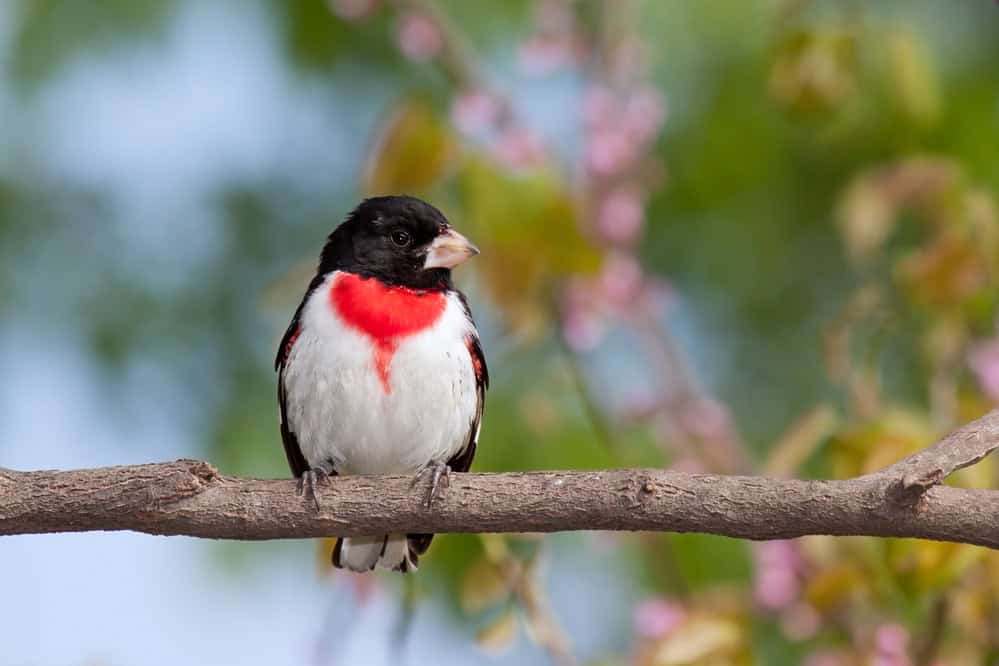
- Species Name: Pheucticus ludovicianus
- Length: 18 cm to 22 cm
- Weight: 35 grams to 65 grams
- Wingspan: 29 cm to 33 cm
Are you a fan of birds with dramatic plumage? The rose-breasted grosbeak is so vibrant, they seem more at home in the jungle instead of plains.
Appearance
The male rose-breasted grosbeak is dressed to impress. He has a black body, white belly, and characteristic cherry-red throat. His pale bill and white wing bars complete the look – he almost looks like he’s wearing a tuxedo.
The female rose-breasted grosbeak is the complete opposite. She has a light brown body with a cream belly and pink bill.
Range
These finches are usually just passing through South Dakota. You’ll see them in the midwest portions of the state during migration, though they’ll linger in the west during breeding season.
Rose-breasted grosbeaks actually prefer more ambiguous environments. Instead of dense forests or mountains, they enjoy open spaces such as parks, forest edges, and fields.
Diet
Rose-breasted grosbeaks will eat just about anything. They forage for insects, dig around for seeds, and sip on nectar.
These finches will visit your backyard bird feeder if you have black oil sunflower seeds. However, try to use a platform feeder – they’re a little on the larger side.
Birdsong
Despite their fancy plumage, this bird believes in the ‘less is more’ phrase for their birdsong. These finches often have sparse whistles and chirps.
Fun Fact
Both male and female rose-breasted grosbeaks will sing, especially when they’re tending to their nest.
Black-Headed Grosbeak
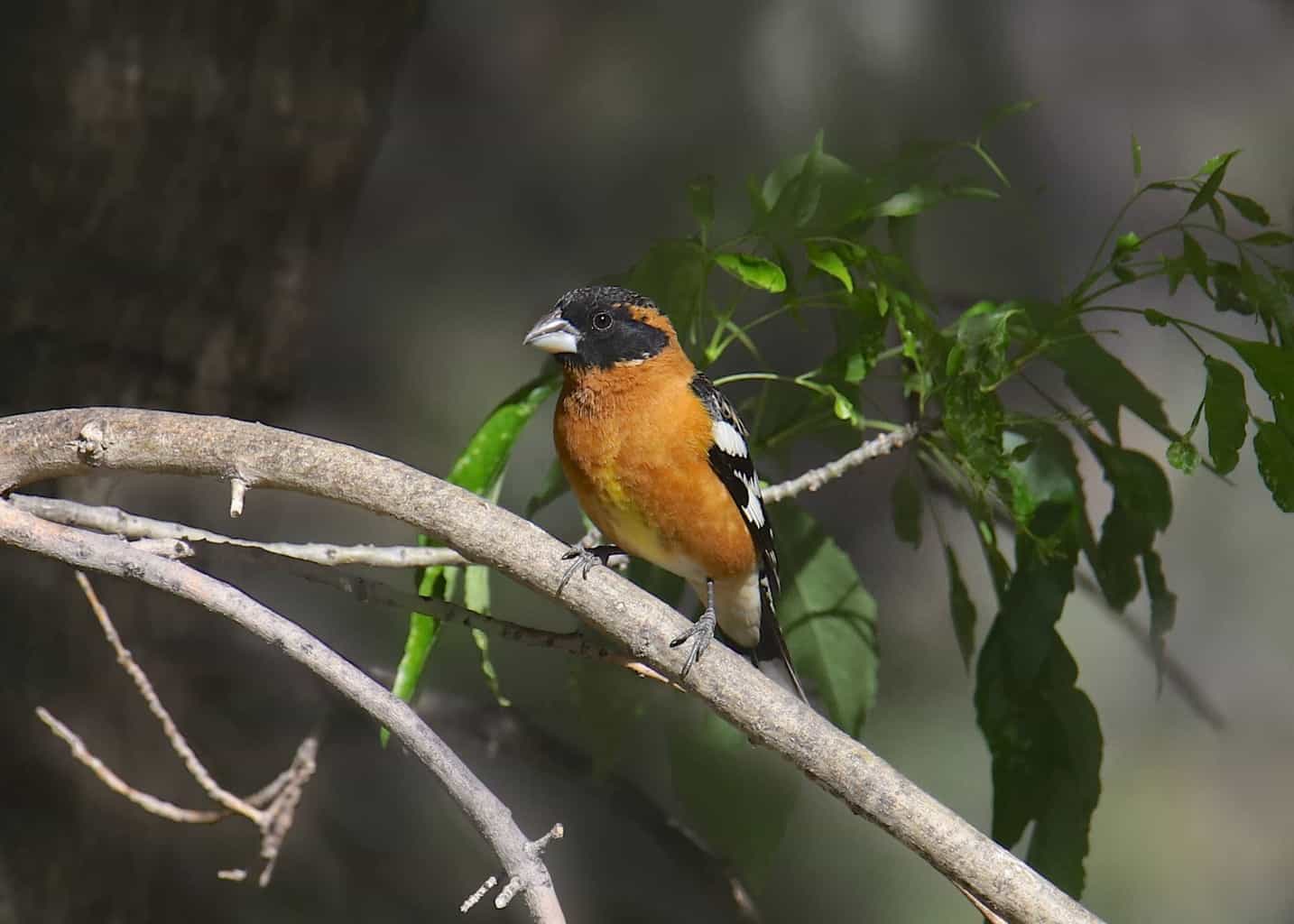
- Species Name: Pheucticus melanocephalus
- Length: 18 cm to 19 cm
- Weight: 34 grams to 48 grams
- Wingspan: 32 cm
I’ve always thought these finches were the embodiment of autumn. As it stands, they usually show up in South Dakota during the spring!
Appearance
Male black-headed grosbeaks make it clear where they get their name from. These charming finches have a black head, gray bill, and bright orange body.
Their wings are dark gray or black with flecks of white. They look splattered with paint.
The female black-headed grosbeak looks very similar to the male but with paler orange and a streaked head.
Range
Expect to see these stocky birds in the southwestern portion of the state during breeding season. They generally prefer deciduous forests and mixed forests, but they’re also rather fond of shrubs.
You’ll occasionally see this bird in suburban areas, too (as long as they’re quiet and well-tended).
Diet
Black-headed grosbeaks enjoy a classic finch diet – just about everything! They’ll forage for berries, seeds, insects, nectar, and fruit.
Interestingly enough, they’re particularly fond of snails and spiders.
Attract black-headed grosbeaks to your feeder with sunflower seeds. They may even visit your nectar feeders if they’re feeling peckish.
Birdsong
This finch has a soft and charming call that sounds like a distant whistle. They’ll sometimes warble and sometimes trail off into wispy chirping notes.
Fun Fact
Did you know this finch is one of the rare species able to eat poisonous Monarch butterflies? I guess it’s not a coincidence their plumage is orange, black, and white!
Common Redpoll

- Species Name: Acanthis flammea
- Length: 12 cm to 14 cm
- Weight: 11 grams to 20 grams
- Wingspan: 19 cm to 22 cm
Add on the darling common redpoll as another must-see winter finch. These birds only show up once it gets cold in South Dakota, but you’ll recognize them quickly.
Appearance
The male common redpoll is a round little fellow with a light brown body and red forehead. His tiny yellow beak gives him a sparrow-like appearance.
His chest will also have a hint of red leaning toward pink.
The female common redpoll looks almost identical to the male but with a slightly lighter body and no pink on her chest.
Range
While this bird usually prefers boreal forests with plenty of coverage, they’ll sometimes leave their usual stomping grounds. They’re scarce in South Dakota, but their migratory patterns sometimes have them popping up for a visit.
Diet
Common redpolls are big fans of birch and alder seeds, particularly when it gets cold. They also visit bird feeders if they’re stocked with thistle or hulled sunflower seeds.
Birdsong
These finches have a jaunty and lively call of chit-chit-chits and chr-chr-chrs.
Fun Fact
Common redpolls are hardy finches who tough it up during the winter months (unlike me). They can withstand temperatures of –65 degrees Fahrenheit!
Hoary Redpoll
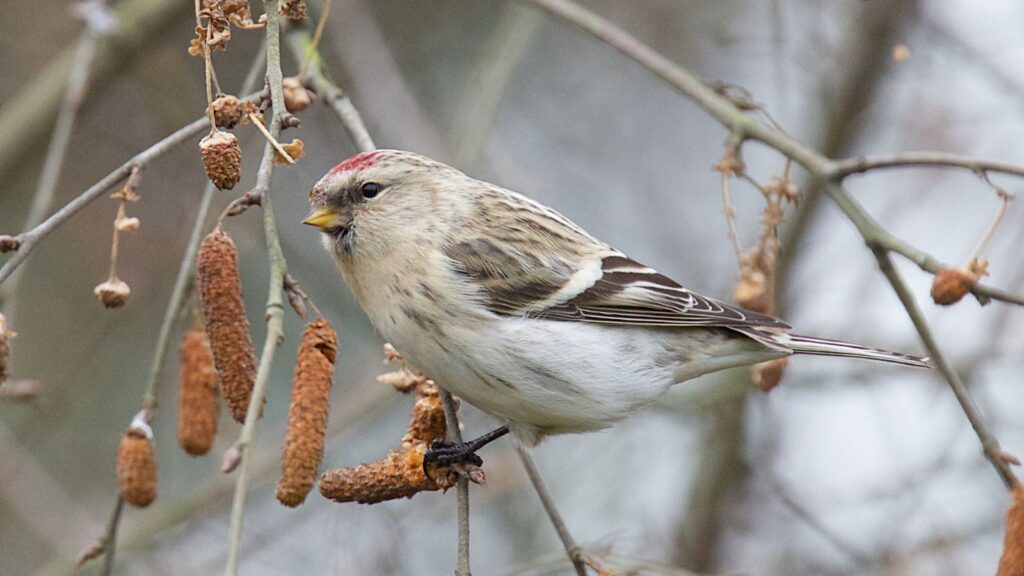
- Species Name: Acanthis hornemanni
- Length: 12 cm to 14 cm
- Weight: 11 grams to 20 grams
- Wingspan: 22 cm to 23 cm
The common redpoll and hoary redpoll are quite similar. In fact, they’re so similar they may be the same species!
Appearance
The male hoary redpoll is distinctive from the male common redpoll for its brighter coloration. He has an almost white body with light, chestnut brown on his wing bars.
The female hoary redpoll looks similar to the male but with an even brighter stomach. You may see faint streaking, but you may not.
Range
These birds usually make their home in the arctic tundra, so it’s no wonder they show up rarely in South Dakota. However, when food supplies get low, they’ll go outside their usual migration patterns.
As such, you’re most likely to glimpse this bird during the winter months (and extra likely if you have a well-stocked feeder).
Diet
Seeds are the go-to diet for the hoary redpoll, particularly birch and alder seeds. They’re very fond of fatty black oil sunflower seeds when it gets cold, so stock up and keep an eye out!
Birdsong
These finches have a sharp and chattering call, often repetitive with cheet-cheet-cheet notes.
Fun Fact
The hoary redpoll is so well-known for its hardy nature during winter that it’s also known as the Arctic redpoll.
Gray-Crowned Rosy-Finch

- Species Name: Leucosticte tephrocotis
- Length: 14 cm to 16 cm
- Weight: 22 grams to 60 grams
- Wingspan: 33 cm
These finches are truly a sight to behold! Their coloration is both dusky and bold, a unique combination just begging for a few snapshots.
Appearance
The male gray-crowned rosy finch has a cinnamon-brown body with a dusting of pink along his stomach. His bright gray head is only matched by his gray wings and legs.
The female gray-crowned rosy finch looks almost identical to the males, but with less pink and a yellow beak.
Range
These finches are rather scarce in South Dakota and usually show up in the southwestern portion of the state. While you’ll see them during non-breeding season, they’re most likely to show up during winter when their food supply runs out.
These beautiful birds enjoy diving in and out of snowfields to find their favorite foods.
Diet
Gray-crowned rosy-finches eat plenty of insects during the summer, especially cutworms. However, they prefer fatty seeds and grasses during the winter.
These colorful finches love black oil sunflower seeds as much as the next bird but with a twist! They’re more likely to visit if you use a platform feeder or scatter the seeds on the ground.
Birdsong
While I love warbles and twitters, I think the gray-crowned rosy finch is charming in its own right. Their call is more mumbled with low chitters and chirps.
Fun Fact
While some finches will dig with their feet, the gray-crowned rosy finch prefers to dig with their beak.
American Goldfinch

- Species Name: Spinus tristis
- Length: 11 cm to 13 cm
- Weight: 11 grams to 20 grams
- Wingspan: 19 cm to 22 cm
If outdoor birding is the last thing you want to do during winter, the American goldfinch will meet you halfway. These iconic finches are most common in the state during the warm spring months.
Appearance
The male American goldfinch is absolutely adorable in his lemon-yellow plumage. He has black wings, white wing bars, and a vivid orange bill.
Most notably, you’ll notice he has a jet-black cap that makes him look quite fashionable.
The female American goldfinch looks similar to the male but with a twist! She has no black cap and veers toward a soft olive-yellow.
Range
American goldfinches show up in most of the state during breeding season. However, in the southeastern portion of the state, they’ll linger year-round.
These birds are quite comfortable in lush and overgrown areas like state parks, gardens, and backyards. They’re quick to visit a feeder and won’t hesitate to bring their friends.
Diet
American goldfinches have quite a varied diet. They’ll eat seeds and flower buds like most finches, but they also enjoy a little bark or maple sap.
Larger bird species can’t use tube feeders, so switch up your feeding station to attract American goldfinches. They’re rather fond of thistle and sunflower seeds!
Birdsong
I could listen to these birds all day. American goldfinches have a cheerful and sunny call filled with warbles and sweet chirps.
Fun Fact
The male American goldfinch is only a bright yellow during breeding season. The rest of the year he shifts to an olive shade, making him look quite similar to the female.
However, the female doesn’t have a black cap, so keep an eye on their head when differentiating between them.
Red Crossbill

- Species Name: Loxia curvirostra
- Length: 14 cm to 17 cm
- Weight: 40 grams
- Wingspan: 25 cm to 27 cm
Does this finch have an overbite? Rather, their criss-crossed beak is a unique adaption to their favorite food source.
Appearance
The male red crossbill isn’t always red! These finches can be brick red or yellow-orange with black wings and thin, white wing bars.
The female red crossbill is never red. She has a light gray body with yellow on her chest and rump.
Range
Since these finches much prefer coniferous forests, they’re not a common sight in the flat plains of South Dakota. However, they are quite adaptable and will travel great lengths for food availability.
Diet
Red crossbills are usually hard at work digging for conifer seeds, but they’ll eat flower buds and weed seeds, too.
They’re also fond of the occasional berry once the weather warms up. See if you can attract them with black oil sunflower seeds during the winter months.
Birdsong
These beautiful finches will sometimes warble and sometimes let out metallic clinking notes.
Fun Fact
Since these finches will switch up their feeding patterns year after year, scientists prefer to identify them by their call.
White-Winged Crossbill
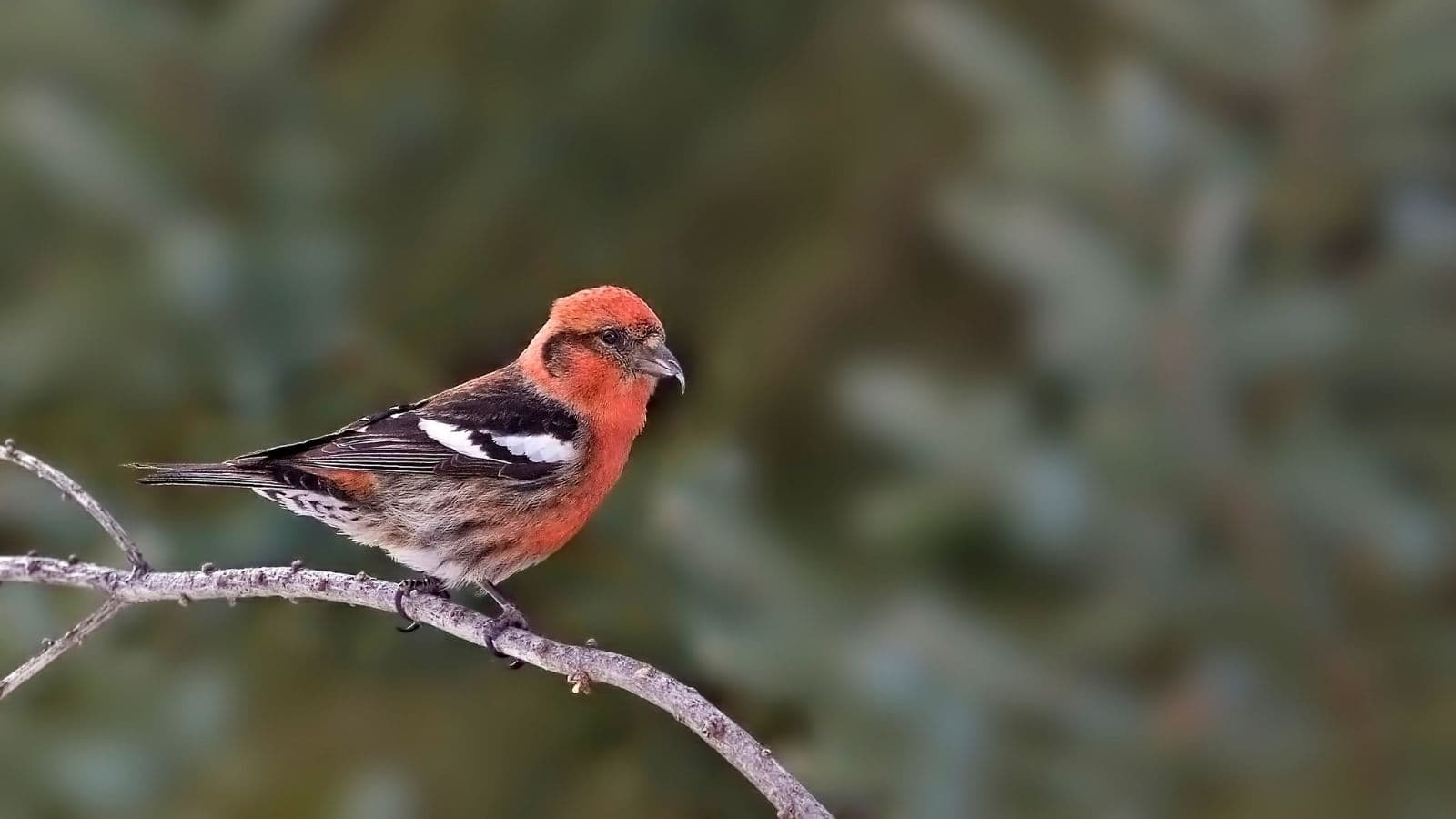
- Species Name: Loxia leucoptera
- Length: 15 cm to 17 cm
- Weight: 24 grams to 26 grams
- Wingspan: 26 cm to 28 cm
It’s easy to get the red crossbill and white-winged crossbill mixed up, but they have a few differences. You’ll notice the most obvious by their wings.
Appearance
The white-winged crossbill also has a criss-crossed beak with a red body and dark wings. However, their wing bars are much thicker than their red cousins.
The female white-winged crossbill has a dusky tan-yellow body with dark wings and white wing bars.
Range
These finches are rare in South Dakota but may pop up more frequently in the northeastern portion of the state. They’re a staple sight in coniferous forests, so you may see them in the state’s famous Black Hills and Badlands.
Diet
Spruce and tamarack seeds are their main squeeze, but they won’t pass up a well-stocked feeder. Try attracting them with hulled sunflower seeds.
Birdsong
These birds chirp so fast they sound like a sprinkler. Expect to hear sharp, fast chi-chi-chis and trills.
Fun Fact
The white-winged crossbill builds a cute, cup-like nest during breeding season.
Cassin’s Finch
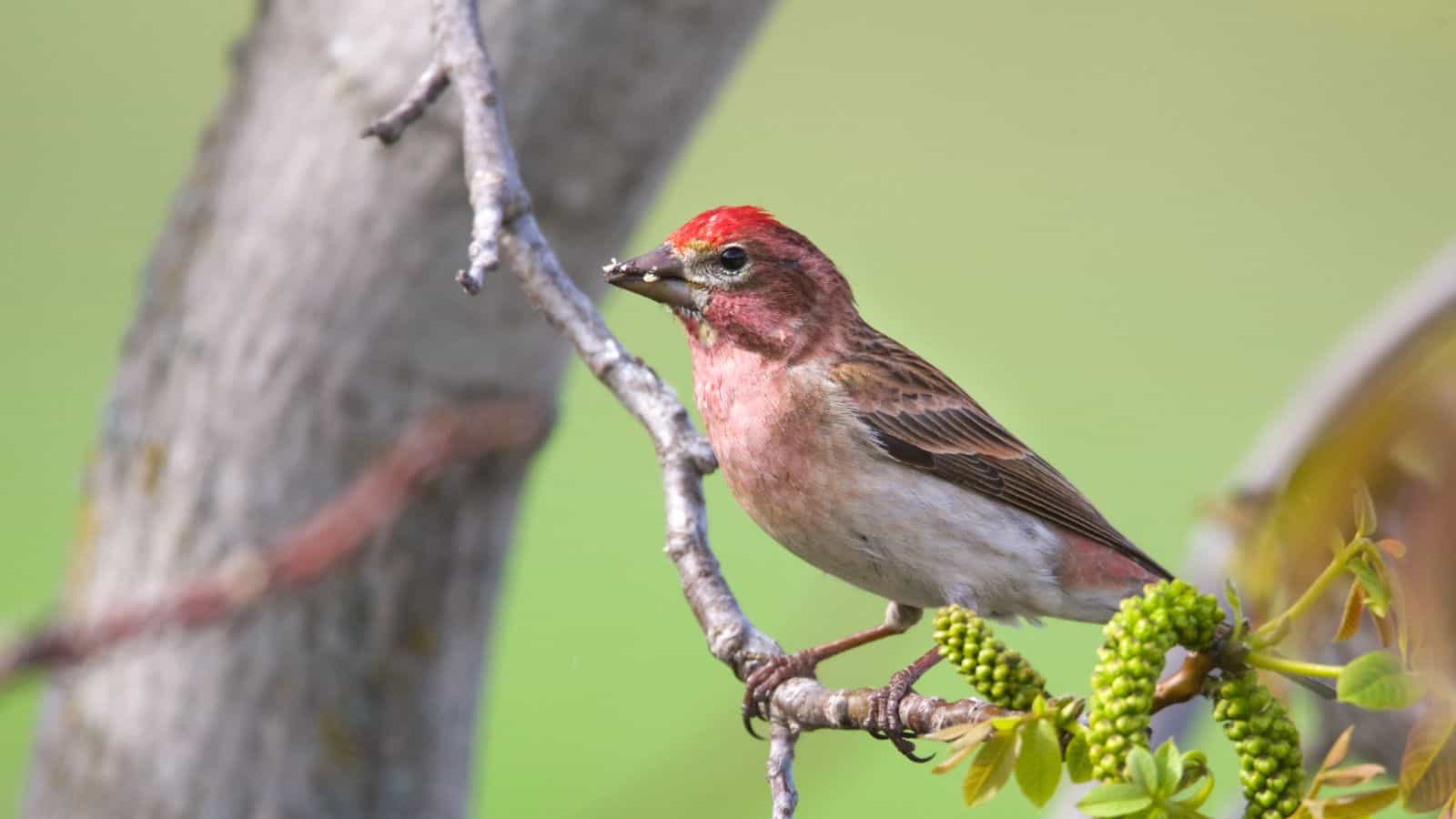
- Species Name: Haemorhous cassinii
- Length: 16 cm
- Weight: 24 grams to 34 grams
- Wingspan: 25 cm to 27 cm
This little finch is quite confusing for beginning birders! They look similar to the purple finch and the house finch, but I’ll help you find the differences.
Appearance
The male Cassin’s finch has a brown body with a streaked belly and red head. They often have a little ruffle that sticks out like bedhead.
Male Cassin’s finches have longer beaks than purple finches and aren’t as sleek as the house finch.
The female Cassin’s finch has a very streaked body, almost like she’s been dusted with pepper. She has brown wings, white streaks, and a spotted belly.
Range
This finch is quite scarce in South Dakota but shows up in the western portion of the state during breeding season. They’re big fans of shrubby environments, but will sometimes peck at the road for a little salt.
Diet
These finches are quite happy to live on flower buds, seeds, and berries. They also have a regular craving for salt and may eat the occasional insect.
Try attracting these birds to your feeder with fresh sunflower seeds. They may even show up during the winter if their regular food supply gets low.
Birdsong
These adorable birds have a melodious song. They’ll warble, twitter, and sometimes let out a light choo-ee choo-ee.
Fun Fact
The Cassin’s finch often travels in large flocks of several dozen birds. This is one of the reasons a group of finches is called a company or a charm!
Lesser Goldfinch

- Species Name: Spinus psaltria
- Length: 9 cm to 12 cm
- Weight: 8 grams to 11 grams
- Wingspan: 15 cm to 20 cm
This tiny finch seems more like a fairy than a bird! You’ll have a great time observing this bird’s lively flight pattern and beautiful coloration.
Appearance
The male lesser goldfinch has a shiny black body with a yellow belly and speckled white wings. Interestingly enough, their plumage can look like a dark, shiny green in some lights.
The female lesser goldfinch has a gentle, olive-yellow body with dark gray wings.
Range
While lesser goldfinches are rather rare, they show up in the western portion of the state during breeding season. They actually don’t care for dense forests and prefer shrubby or lightly forested areas.
Diet
These tiny birds eat suitably tiny food. They often nibble on flower buds and weed seeds.
You can attract these finches to your yard if you stuff a sock feeder full of thistle. These lightweight birds will have no problem latching on and eating their fill.
Birdsong
These adorable birds will alternate between twitters and chirps. However, they sometimes let out very high-pitched notes.
Fun Fact
Lesser goldfinches are also fond of being near water. You might attract more to your feeder if you also keep a well-tended birdbath!
South Dakota Is a Great Spot for All Kinds of Birders
South Dakota’s breathtaking landscape is a fantastic pick no matter what kind of birder you are. As someone who enjoys more relaxed bird-watching experiences, this detail is a major plus in my book.
If you’re an avid hiker or camper who wants to explore the state’s terrain, South Dakota has plenty of national parks for birdwatching. If you prefer backyard birding or visiting a quiet park, you’ll be in good hands, too.
What other birds can you find here? Our fun guide on birds in South Dakota will give you a breakdown of 26 different species!

